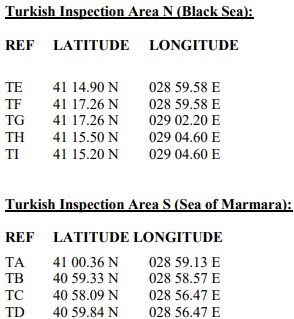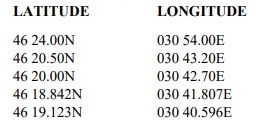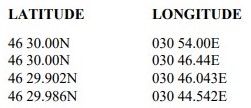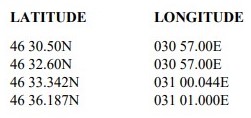IMO informed about updated procedures regarding the Black Sea Grain Initiative. According to the latest update, the Joint Coordination Centre (JCC) approved the final version of the “Procedures for Merchant Vessels” engaged in the Initiative.
On 22 July 2022, Russian, Turkey, and Ukraine signed The Initiative on the Safe Transportation of Grain and Other Foodstuffs from Ukrainian Ports (Black Sea Grain Initiative).
The Initiative states that a Joint Coordination Centre (JCC) would be established under the auspices of the United Nations, with the representation of the three member states involved, to conduct general oversight and coordination of the Initiative.
On 26 August 2022, the JCC approved the final version of the “Procedures for Merchant Vessels” engaged in the Initiative, which includes the following:
#1 General instructions
- The Initiative can only authorize the export of cargo from the Ukrainian ports. The Initiative cannot authorize the import of cargo into the Ukrainian Ports.
- All vessels shall transmit on Automatic Information System (AIS) at all times whilst participating in the Initiative.
- The operations within the Initiative will be coordinated by the Joint Coordination Centre (JCC) in Istanbul, by representatives of the three parties and the United Nations.
- Vessels must be at Maritime Security (MARSEC) level 3 in compliance with the requirements of the government of Ukraine by the time they arrive at the Turkish Inspection Area (see below) and to be prepared for inspection as described in paragraph 31.
- As a vessel moves through the Maritime Humanitarian Corridor, it is additionally protected by a buffer zone. The buffer zone is a circle, 10 nautical miles in radius based on the centreline of the corridor. The buffer zone moves along with the vessel. The buffer zone does not extend past either terminus of the Maritime Humanitarian Corridor. No military ships, aircraft or UAV will close to within 10 nautical miles of a merchant vessel transiting the Maritime Humanitarian Corridor. Vessels encountering provocations or threats while transiting the Maritime Humanitarian Corridor should report immediately to the JCC.
- In addition, the JCC will provide vessel movement information in the Maritime Humanitarian Corridor to all the Parties. Those representatives will transmit that information to all their military authorities, to prevent incidents. If the military authorities have no objection, the JCC representatives from each Party will acknowledge that all military ships, aircraft and units in the area have been notified, and that the vessel can move safely. If a JCC representative informs the JCC of a threat to the merchant vessel (such as military action in the area), the JCC may take action to ensure the safety of the vessel.
- In the case of receiving information regarding a change in the time or date of approach of vessels to the Turkish Inspection Area, the Ukrainian authorities will notify the JCC. If adverse weather does not allow for inspections in one of the Turkish Inspection Areas, vessels will receive instruction on inspection from the Istanbul Port Authority.
- The following procedure has been developed by the parties and shall be followed by all merchant vessels planning to export grain, foodstuffs and fertilizers, including ammonia from the Ukrainian Ports.
#2 Vessels routing
As BIMCO had informed earlier, JCC announced a new route for merchant vessels going in and departing from the three Ukrainian ports of Odesa, Chornomorsk, Pivdennyi/Yuzhny under the Black Sea Grain Initiative.
The new route is 320 nautical miles long and connects the three Ukrainian ports with the inspection areas inside Turkish territorial waters.
- The Turkish Inspection Areas are situated in areas with the following coordinates:

- Entrance to the Port of Chornomorsk Waypoints from the Holding Area to the port of Chernomorsk (Chornomorsk) (Channel width – up to 200 metres):

- Entrance to the port of Odesa Waypoints from the Holding Area to the Port of Odesa (Channel width – up to 200 metres):

- Entrance to the Port of Pivdennyi Waypoints from the Holding Area to the Port of Yuzhny (Pivdennyi) (Channel width – up to 200 metres):

#3 Preparing for inspection
- The vessel should implement the requirements of MARSEC Level 3, as defined by the Government of Ukraine, from the Turkish Inspection Area to the Ukrainian ports, for inbound vessels, and vice versa for outbound vessels.
- For bulk carriers, cargo hatches open, if safe, and cargo and machinery areas ready for inspection. Vessels must confirm that any confined spaces being inspected are safe for entry.
- All vessels documentation available, including crew list and tank sounding logs.
#4 Transiting to or from Ukrainian territorial seas
- To avoid the danger of floating mines or misidentification in the zone of military activities, vessels must plan their transit of the Maritime Humanitarian Corridor during maximum daylight hours, that is, between 0500 and 2100.
- All vessels transiting the High Seas Corridor must remain in the corridor at all times. Vessels shall display the appropriate lights or day shapes for a vessel restricted in its ability to maneuver (COLREG Rule 27) while transiting in the corridor. Vessels transiting at nighttime or in restricted visibility should illuminate their deck lighting.
- Inbound vessels transiting the High Seas Corridor must proceed, without deviation, to the Ukrainian Territorial Seas Holding Area, maintaining a sharp lookout for floating hazards. The Southern Waiting Area may be used by inbound vessels to await 0500 before commencing the transit.
- Outbound vessels, upon departing Ukrainian Territorial Seas, should proceed through the Entrance to the Ukrainian Territorial Seas area to point JE, the entrance to the High Seas Corridor. Vessels should maintain a sharp lookout for floating hazards.
- For vessels inbound to Ukrainian ports: Inspection should be conducted only after the vessel has completed all actions such as: bunkering; crew change; receipt of supplies; hull cleaning;
- For outbound vessels from Ukrainian ports: Inspection must be carried out before the vessel performs any of the actions listed above while in the Turkish Inspection Area.






























































